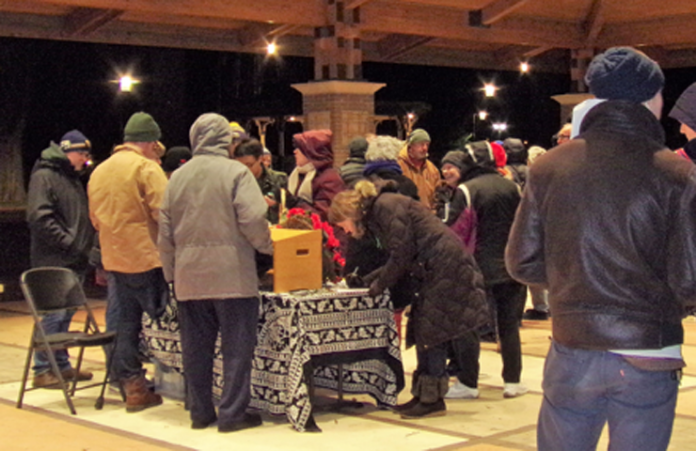“We Are Not Finished”: 26 Days of Action against Gun Violence Culminates, Continues
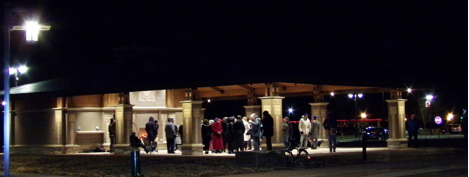
By Michael McAllister
In a moving blend of camaraderie and solemnity, Grinnell’s 26 Days of Action against Gun Violence came to a decisive point Thursday night, December 14, in Central Park.
But the ceremony signaled both explicitly and implicitly that the effort to understand and discuss gun violence is not over.
Earlier this fall, an informal group of Grinnellians concerned about the issue of injuries and deaths by firearms in the United States formed a loose organization—no chairperson; no steering committee—and recognized that Grinnell is unique: No other town in the nation is home to the president of the National Rifle Association.
As the matter was discussed among participants, the idea of a 26-day movement emerged—26 being the number of adults and children employed by or students of Sandy Hook Elementary School in Newtown, Connecticut, murdered on the morning of December 14, 2012.
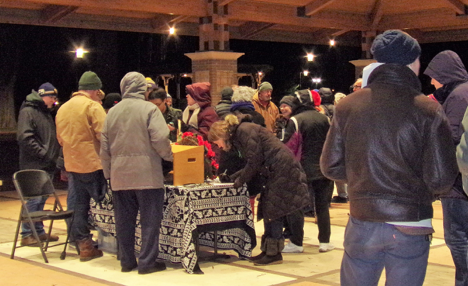
Thursday night’s vigil on the fifth anniversary of that tragedy climaxed a series of dramatic events that began on Sunday, November 19. Activities included panel discussions, legislative notification campaigns, testimonies from those directly affected by the Newtown tragedy, a silent walk, and more than one request for dialogue with Pete Brownell who heads Brownells, “the leading supplier of firearm accessories, gun parts, and gunsmithing tools,” according to the company’s website. Brownell, a man who has unquestionably contributed greatly to Grinnell and to Poweshiek County, was elected president of the NRA in May of this year.
Throughout the campaign, the emphasis has been not on protest but on a desire to initiate discussion, and one of the people with whom conversation was sought was Pete Brownell.
Many Grinnellians first learned of the initiative through a letter from George Drake to the Grinnell Herald-Register, published in the Thursday, November 9, edition.
“We strongly urge the community to come together to discuss gun violence in our country and strategies for reducing it,” Dr. Drake wrote.
Thursday night’s events included reading the names and ages of victims of the Sandy Hook shooting and a segment during which those in attendance could state the name of a family member or a friend killed by a gun. Approximately 16 names were called.
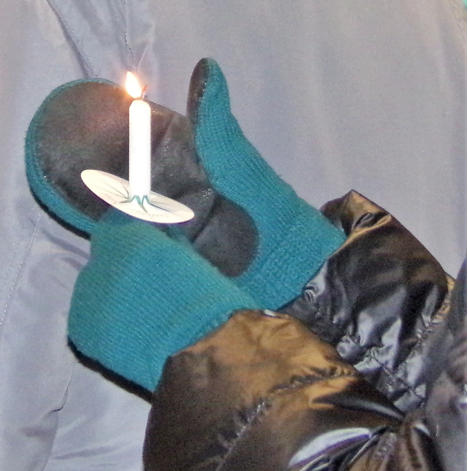
The most detailed presentation came from Dr. James Paulson, a gun owner, of Grinnell who began with the assertion that “gun violence should be seen as the major health crisis that it is.” Using analogies for illustration, he stressed that, if the number of deaths in the United States due to gun violence each year were instead deaths from a specific disease or specific events such as airline crashes, citizens would demand action.
Paulson referred to cultural changes that have occurred in the last fifty years. Smoking is no longer the symbol of sophistication it once was. Nor is alcohol. Even automobile manufacturers, which once boasted of big fins, big engines, and big power, now stress safety, fuel economy, and reduced environmental impact.
The same shifts in attitudes could occur with firearms.
Dr. Paulson also introduced a topic not often discussed within the issue of gun violence—that of suicide.
The drive toward suicide, he noted, can be an instantaneous decision, and if there is an instantaneous method of completing the act available—i.e., a gun—odds are that the act will be successful. He contrasted the statistic that 90% of gun-attempted suicides are successful whereas 90% of non-gun-attempted suicides are not. And members of the latter group in most cases do not attempt suicide again.
Although we pride ourselves on being rational, most of the beliefs that we hold are based on emotion, Dr. Paulson noted. When people feel threatened, they resort to defensive positions—to tribalism, to use a word gaining more and more prominence these days. He urged those in the audience to read, to research, and to investigate.
Dr. Paulson closed with comments concerning overemphasis on drug criminalization that the so-called War on Drugs has produced and the mental health consortium that he and colleagues have set up to deal locally with Iowa’s mental health crisis.
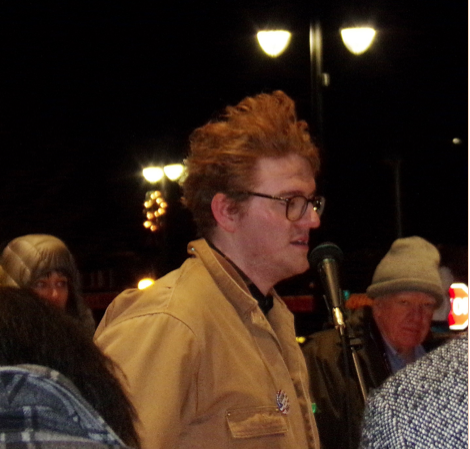
Grinnell native and current Grinnell College student Patrick Armstrong (above) spoke next, thanking organizers for an environment in which activism can flourish. “Growing up here was indeed a privilege,” he stated, and he went on to stress the ideals of conversation and cooperation as residents work to mitigate the specter of gun violence.
Another short but emotional presentation followed from Amber Gustafson (below), active in the volunteer group Moms Demand Action and a Democratic candidate—she was once a Republican—for Iowa Senate District 19, which includes Ankeny.
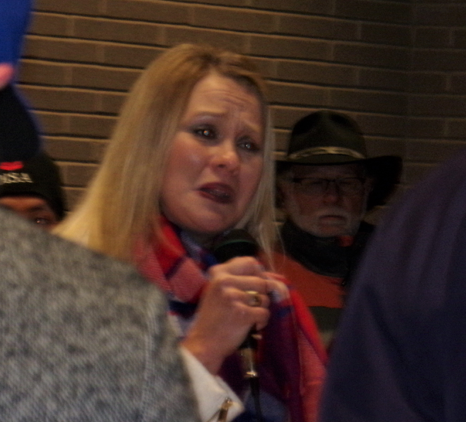
“This is a hard fight,” Gustafson declared. “It takes a lot out of us.”
And she offered a rallying call: “Keep going!” The audience repeated the phrase at her urging, underscoring the message of earlier in the program: “We are not finished.”
Dondrea Walker, pastor of Grinnell’s First Baptist Church, was the next speaker, offering a moving account of his brother’s death by gun violence. His narrative highlighted the enticement that can captivate a young man in a culture that glorifies guns.
Silence takes many forms. There is the silence at a memorial service, subtly punctuation by shuffles, coughs, and sniffles as people try to retract their tears. There is the silence that takes root forever in a family when a mother or father or child has been murdered by a gun. There is the silence of a legislator who fears confronting a group that represents a minority controlled by a still smaller but intensely vocal sub-minority. And there is the silence of a person of influence who seems to choose not to speak.
As for progress toward eliminating gun violence in the United States, that last form of silence may be the most chilling of all.



